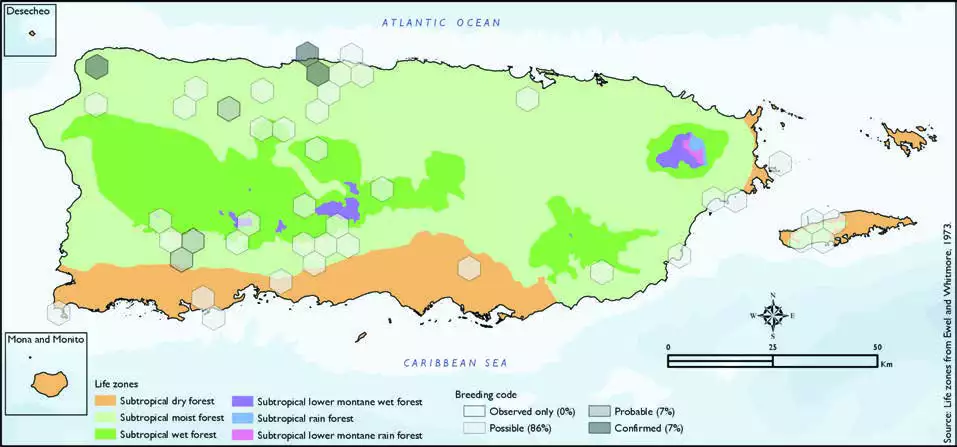Key West Quail-Dove
Description
The Key West quail-dove (Geotrygon chrysia) is a species of bird from the doves and pigeon family Columbidae. It is probably most closely related to the bridled quail-dove.
The Key West quail-dove is approximately 27–31 cm in length. The bird is distinguished by having a dark rust-colored back and similarly colored wings. It has some amethyst or bronze green iridescence on its crown, nape and in the back of its neck. The mantle, back, rump and inner wing coverts show some purplish red iridescence. It also has a bold white facial stripe. Its call is similar that of the white-tipped dove.
Distribution & Habitat
The Key West Quail-Dove is a species native to the Greater
Antilles and The Bahamas
(Raffaele and others 1998). In
Puerto Rico, this species has
been reported for the mainland,
Mona, and Vieques (Biaggi
1997, Bowdish 1902, Raffaele
1989a), in the latter being a
rare to extremely rare resident
(Gemmill 2015). In Puerto Rico,
it is known from western Ponce
in the southern region and from
Arecibo to Isabela among the
haystack hills of the northern
coast. Nonetheless, a population
was reported from the southern
area of the Tortuguero Lagoon
(Raffaele 1989a). It usually
inhabits coastal forested areas
and wooded, scrubby thickets
in arid areas (Saliva 1994). It is difficult to observe as it is more
frequently found on the ground
than in trees (Biaggi 1997).
The species mostly inhabits the
understory of dense forests with
ample leaf litter, primarily in arid
and semi-arid areas. However,
it has also been documented in
moist and wet mountain forests
with undisturbed understory
(Raffaele and others 1998). The
atlas fieldwork yielded a total of
63 records within 44 hexagons
or 9 percent of the 479 total
hexagons (see map). Of the 44
hexagons where this species
was found, breeding met the
atlas definition of confirmed in
7 percent (3) of the hexagons,
probable in 7 percent (3), and
possible in 86 percent (38)
(see map). Key West Quail-Dove distribution. The map shows the highest breeding code by hexagon and overlaying the ecological life zones in
Puerto Rico. Note: percentages may not total 100 due to rounding. 57Key West Quail-Dove/Paloma Perdiz Áurea

Breeding Habits
The Key West Quail-Dove builds its nest of branches and plants
(Biaggi 1997). The nests are
usually built above the ground
in bushes or small trees and are
commonly located either on the
ground or in low undergrowth
among bromeliads (Raffaele
1998). Atlas results show that this
species breeding season extends
mostly from January to August,
with the most breeding activity
from March through June, and
to a lesser extent from October
to December (see chart). Results
show that this species breeds within the subtropical moist
forest life zone (66 percent of the
hexagons) at the northern karst
region of the island, although
it is considered possible for it
to breed in the subtropical dry
forest life zone (16 percent of
the hexagons) as well as in
the subtropical wet and lower
montane wet forest life zones (18
percent of the hexagons) (see
table and map).
Conservation
The global population trend of the Key West Quail-Dove has not
been quantified or assessed, but it is described as fairly common
(Stotz and others 1996). This
species is currently listed as a
species of least concern by the
IUCN (BirdLife International
2016). Locally, this species is not
listed in any of the threatened
categories of PRDNER and
USFWS. In Puerto Rico, the Key
West Quail-Dove has a protected
habitat in land of 24 percent or
255 km2 of the total area covered by the hexagons where evidence
of breeding was found for this
species (1052 km2).
Related Species
Family:
dove